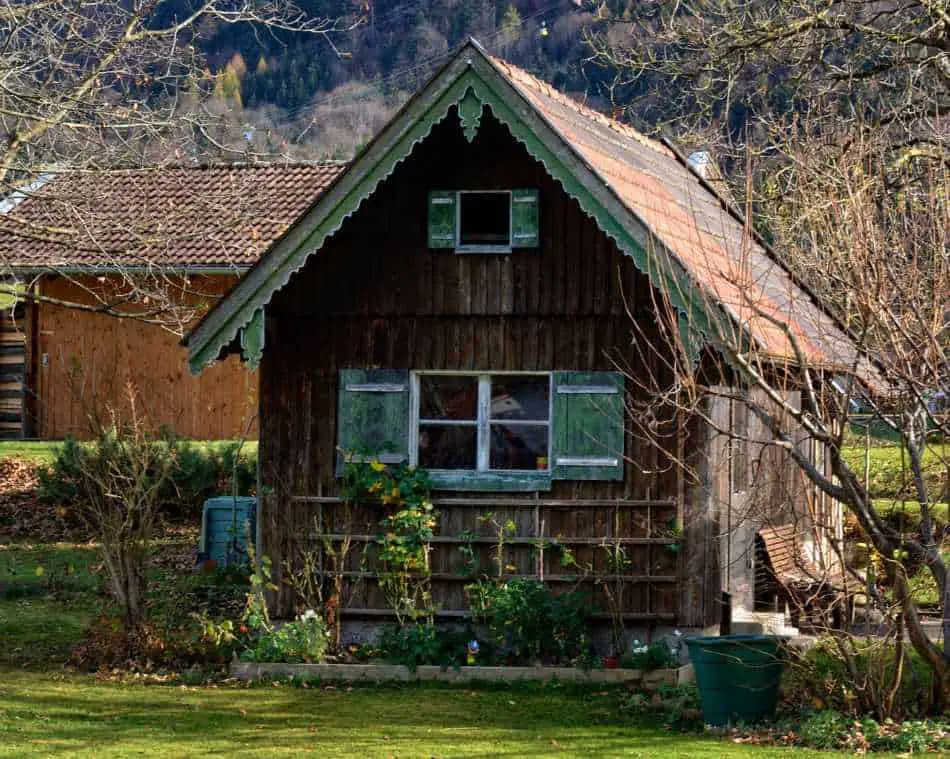Almost all portable generators require some protection from the elements. Can you run a generator in a shed? That seems like the simplest solution, especially if you already have a shed to place it within. However, anything that puts off exhaust is more complicated than that when it comes to enclosed spaces. Making the wrong choice when deciding where to locate your generator is detrimental to your health. More importantly, it can kill you. I will explain why you can’t simply plug your generator into your existing shed and show you how to work around the issue safely. No one wants to get sick or end up dead because they forgot about exhaust, but you also shouldn’t have to replace your generator because it was overexposed to rain or stolen as it sat in the yard.
Can you run a generator in a shed? You cannot run a generator in a shed. Placing a generator indoors is the worst and possibly the last choice you will ever make. Fumes from the running generator build-up and inhaling them will send you to the hospital. Instead, consider creating a unique, well ventilated, smaller shelter for your generator.
Can You Enclose a Portable Generator
Please do not try to run a generator in a shed. You cannot do so safely. However, that doesn’t mean that you can’t enclose your portable generator. The ‘trick’ here is to buy or create an enclosure that is slightly larger than the generator. You don’t want anyone going inside with it, for safety reasons.
First, you want to measure your generator. Make sure the dimensions are accurate and include any wheels, handles, frames, or other parts. Next, you should add at least twenty-four inches on every side, but you can add more if you like. Although you don’t want a shed sized space, it is necessary to give your generator ample space for ventilation and safety reasons.
Placing a generator inside a shed is that you have to enter it to turn the generator off. While this might not seem like a big deal, space is holding any emissions from your generator. The only time this would not matter is when you are using a zero-emission, battery-powered generator, which is hard to find.
A solar generator won’t run indoors because it requires the sun’s light to power it, and a gas generator has carbon monoxide gas emissions. While it is generally safe to run a gas-powered generator, doing so in an enclosed space where you have to stand and breathe to turn anything on or off is detrimental to your health. Opt for a smaller enclosure to keep your generator out of the rain or snow.
The All Power America 2000 Watt Portable Generator is ideal for a small generator shed. Additionally, the low-oil shutdown will help prevent accidental burnout, and the one-point-three gallon tank will keep the lights on for a long time. Best of all, this model is heavy-duty and EPA certified. Have Amazon ship to your door by clicking here.
How Do I Protect My Portable Generator from Weather
When it’s not in use, you can store a generator indoors. Sheds, garages, and basements are all fine locations for a dormant generator. Keeping that portable generator out of the weather and away from thieves is essential, not to mention basic common sense.
Depending on the climate where you live, a raised platform and an awning or roof are sufficient to protect some generators from inclement weather. Most arid climates, such as the desert, don’t see much rain, and simply redirecting that water away from a raised generator is acceptable. Especially if you live outside a city where the chances of theft are slim to none, this solution is sensible.
Otherwise, when you live in a damp, rainy, or snowy area, your generator is going to need more protection. In these cases, choose a prefabricated generator shield that is larger than your generator, or build a sufficiently ventilated generator housing yourself.
How Much Ventilation Does a Generator Need
Running your generator in a shed might offer enough ventilation, but it’s never going to be a safe choice. Where proper ventilation is concerned, there are a couple of different approaches, and it’s important to understand both. First and foremost, OSHA requires two to three feet of space around a generator for safety. Naturally, this gives the generator ‘breathing’ room and allows airflow for the combustion process.
According to Taitem.com, “It is important to differentiate between the large amount of outside air required for cooling the generator (approximately 65 CFM per kw, for example, 6500 CFM for a typical 100 kW generator), and the smaller amount of outside combustion air required for the generator itself (approximately 3 CFM per kw, or 300 CFM for a 100 kW generator). Our concern is the negative pressure induced by the large amount of air required for generator cooling. However, in avoiding problems relating to generator cooling, one should not forget to allow for combustion air for the generator itself. “
In short, your generator needs a lot of airflows to operate properly. Look for generator covers that offer slitted sides that are tilted to redirect water away from the enclosure. Alternately, if you plan to DIY, make your calculations carefully and use a prefabricated side-panel that lets oxygen move freely to and from your generator.
A WEN 56475 4750-Watt Portable Generator can keep your essential power on in an emergency. CARB and EPA III compliant, this outstanding generator meets requirements in all 50 states. Plus, the foldable handles and wheel kit make this WEn easier than ever to move around when you need it most. Find out all about it on Amazon by clicking here.
Can You Run a Portable Generator Continuously
Running a portable generator in a shed is something you cannot do. However, it may surprise you to learn that you can run a portable generator almost continuously. Notably, you will need to check the specifications of the model you own before trying this. Additionally, you will ideally need two generators if you want to power something, like your home, perpetually so you can alternate.
It is crucial to take regular breaks from running a generator. Powering down to do basic maintenance and cleaning will help keep your generator functional for longer. Hence, get two to run one and do maintenance on the other for uninterrupted power.
The Durostar DS4000S Portable Generator is from a well known and trusted brand. Its engine has four thousand peak watts of electricity to power anything you need. Best of all, the included oil funnel, wrench, tool kit, and manual make this Durostar easy to use. See the exceptional Amazon reviews by clicking here.
How to Safely Run a Generator in a Garage
Like a shed, you cannot run a generator safely in a garage. Even if your garage is well ventilated, the only way this would work is if no one ever enters the garage. Since you will need to add fuel and access the switches, this is impossible.
Though a garage seems like a large enough space, the simple fact is that it is not. Any enclosed space will allow fumes to build up. A small, ventilated cover is safe to approach because it is outdoors. Meanwhile, a garage is not. The carbon monoxide molecules in generator exhaust can cause headaches, nausea, or even death.
Can You Run a Generator on a Porch
Please do not run a generator on your porch. For one thing, porches are often enclosed. The roof makes this seem like a desirable location, but it is not due to the proximity to your home. Windows, vents, and other air-moving portals will let the emissions into your home, which is dangerous to you and your family or pets. The minor convenience of having that easy access generator can still cause serious long term damage a little at a time.
Instead, always run your generator outdoors. Moreover, a generator should be at least ten feet from your house. The distance acts as a safety buffer and lets the emissions dissipate so that the air is safer to breathe both indoors and near your generator.
If you are concerned about the chords running to your home from the generator coming undone or getting wet, then consider running them underground. A sturdy pipe or length of three-inch PVC tubing is easy to bury so that neither weather nor traffic in your yard can disconnect that chord.
Final Thoughts
Anywhere people go inside is the wrong choice for placing a generator. Running a fume-producing machine where humans or animals breathe will cost you a trip to the hospital or vet if you’re lucky. Unfortunately, those fumes can also kill. Naturally, a solar generator is a different story, but you always need to read the warnings and placement suggestions before choosing a generator.
Build a generator shed with plenty of ventilation where your generator will be safe, and so will your family. Alternatively, you could place the generator on a raised platform with a small awning over it to prevent inclement weather from causing damage. Depending on the climate where you live, this may be a safer solution, especially when it’s sweltering outside.
Don’t risk your life or anyone else’s for a cheap solution to keeping your generator out of the rain. Keeping the lights on is crucial, but so is good generator safety.

